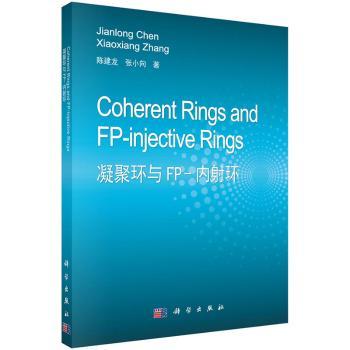内容简介
凝聚环源于Chase[45]在1960年对平坦模的直积的研究。这一概念可以看成Noether环和半遗传环的推广。1989年,Glaz编著的《交换的凝聚环》[160]一书出版了。这本由陈建龙、张小向著的《凝聚环与FP-内射环(英文版)》综合了当时人们所知道的有关交换的凝聚环方面的几乎所有的结果。
三年以后,Glaz又写了一篇关于交换的凝聚环的综述报告,介绍了凝聚环在交换代数中的地位。与此同时,关于非交换的凝聚环的研究也逐渐活跃起来。这正是本书的所要着重讨论的内容之一。
目录
Preface
Notations
Chapter 1? A glance in rings and modules
1.1? Rings and modules
1.2? Complexes, homological dimensions and functors
1.3? Finitely generated and finitely presented modules
1.4? FP-injective and flat modules
Exercise
Chapter 2? Coherent rings
2.1? Definition and examples
2.2? Characterizations of coherent rings
2.3? Extensions of coherent rings
2.4? Some generalizations
Exercise
Chapter 3? FP-injective rings
3.1? Definition and examples
3.2? Characterizations of FP-injective rings
3.3? Extensions of FP-injective rings
3.4? FP-injective and QF rings
3.5? FC rings
Exercise
Chapter 4? Homological dimensions
4.1? FP-injective dimension
4.2? n-FC rings
4.3? Weak global dimension
4.4? Semihereditary rings
Exercise
Chapter 5? Some applications
5.1? Flat envelopes and FP-injective covers
5.2? Gorenstein flat modules
5.3? Gorenstein FP-injective modules
5.4? Gorenstein flat complexes
5.5? Gorenstein FP-injective complexes
5.6? Relative and Tate homology
Exercise
Appendix A? Open questions
Appendix B? Categories and fuctors
Appendix C? Categories of complexes of modules
References
Index
摘要与插图
Chapter 1 A glance in rings and modulesIn this preliminary chapter, we brie.y present some fundamental notions and related results which will be frequently used in the sequel.
1.1 Rings and modules
Modern ring theory rose from early 1900s. As a common generalization of some “concrete” algebraic structures with operations generalizing the arithmetic opera-tions of addition and multiplication, the notion of rings is widely involved in many branches of mathematics. One e.cient approach to investigate a ring, among others, is to study modules over it.
We assume that the reader has been acquainted with monoids and (abelian) groups.
1.1.1 Rings, homomorphisms and ideals
De.nition 1.1.1 Let R be a nonempty set with two binary operations, addition (+) and multiplication (·), such that (R, +) is an abelian group and (R, ·) is a monoid. As usual, the zero element of (R, +) is written as 0, while the identity element of (R, ·) is denoted by 1. The system (R, +, ·, 0, 1) is called an associative ring if the multiplication is distributive over the addition, i.e.,
a · (b + c)= a · b + a · c and (b + c) · a = b · a + c · a
for all a, b, c ∈ R.
Given a ring (R, +, ·, 0, 1) and a subset S of R, if 0, 1 ∈ S and (S, +, ·, 0, 1) is also a ring then we say (S, +, ·, 0, 1) is a subring of R.
We usually abbreviate (R, +, ·, 0, 1) to R and write a · b as ab in R if it does not cause any confusion. The element 1 is called the identity of R. Sometimes we use 1R to emphasize the identity 1 in a ring R especially in case there are more than one ring involved at the same time.
A ring R is said to be commutative provided (R, ·, 1) is a commutative monoid.
By a division ring we mean a ring R in which every nonzero element a is invertible in the sense that ab = ba = 1 for some b ∈ R. It is easy to see that such an element
.1
b is unique if it exists. In this case, we write b = aand call it the inverse of a. An invertible element in a ring is also called a unit.
If R is a ring in which ab 0 for all nonzero elements a and b, then we say
= R is a domain. A commutative domain is also known as an integral domain.A commutative division ring is called a .eld.
Example 1.1.2 Typical examples of commutative rings include Z, Q, R and C. In addition, let R[x] be the set of all polynomials in x with real coe.cients. Then R[x] is also a commutative ring with the usual addition and multiplication of polynomials. All these ring are integral domains. In particular, Q, R and C are .elds.
Example 1.1.3 In linear algebra, we encounter noncommutative rings. For in-stance, let Mn(R) be the set of all n × n matrices over R, where n is an integer greater than 1. Then Mn(R) is a noncommutative ring with the usual addition and multiplication of matrices.
The notion of matrix rings can be generalized to de.ne rings of some in.nite matrices as follows.
Let




 VIP会员
VIP会员